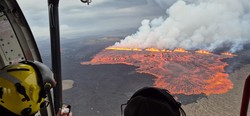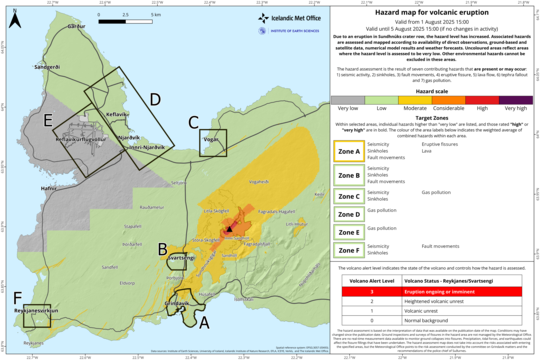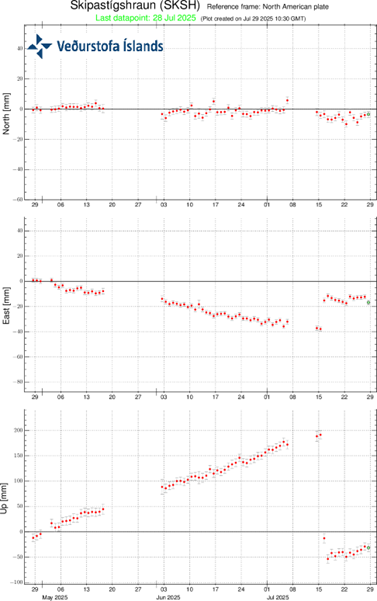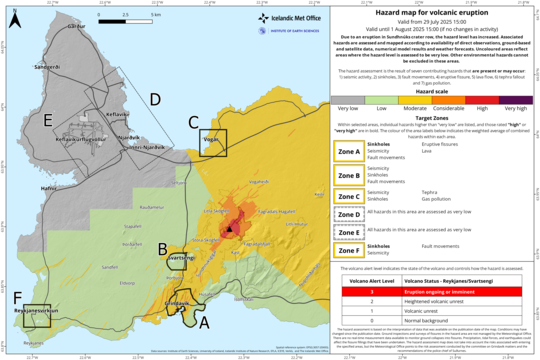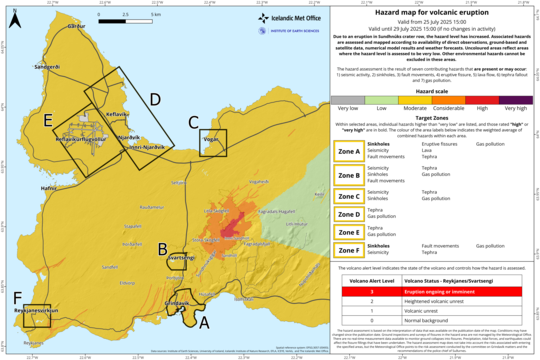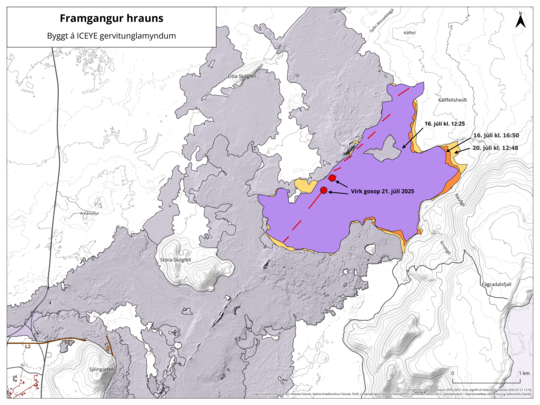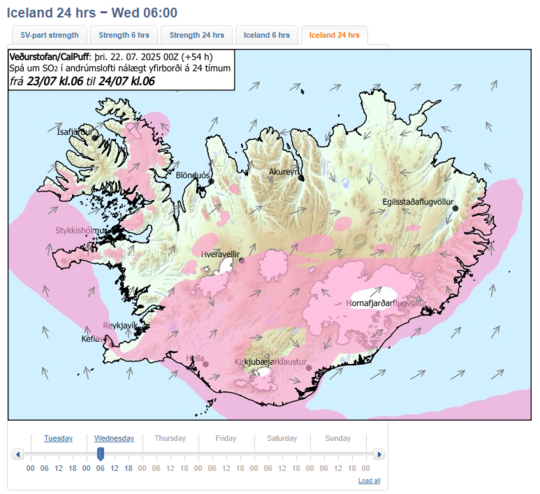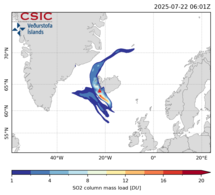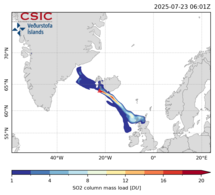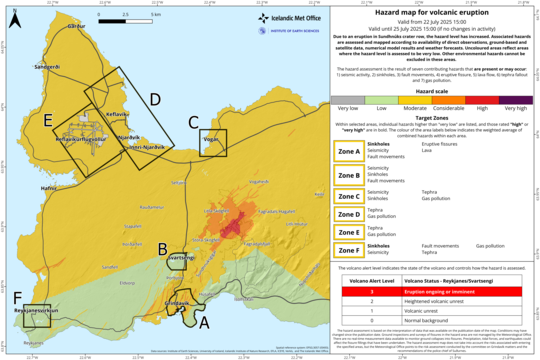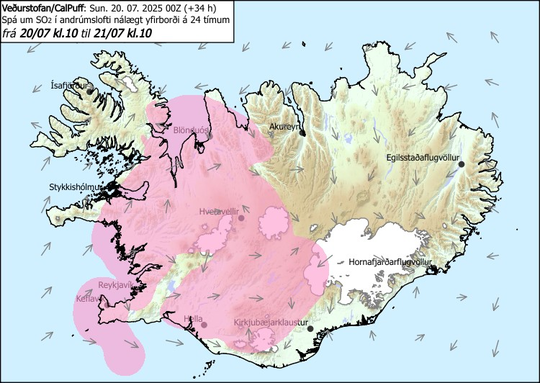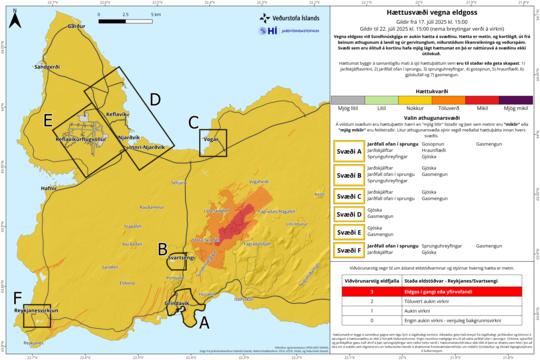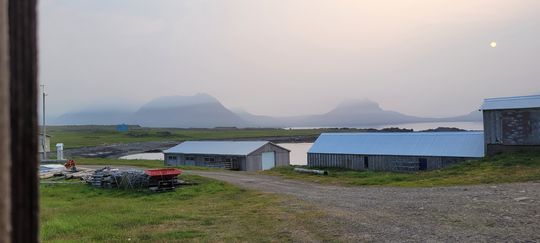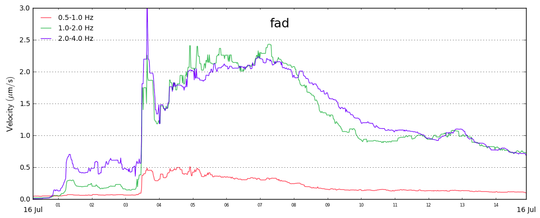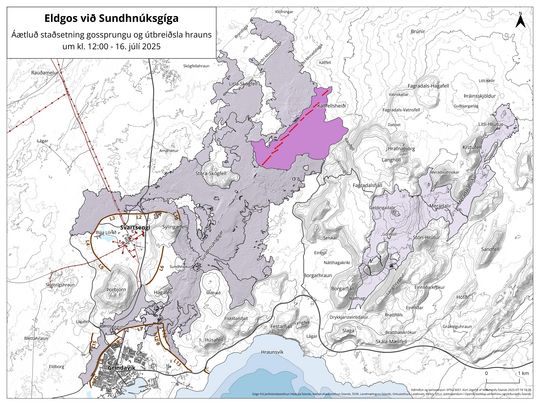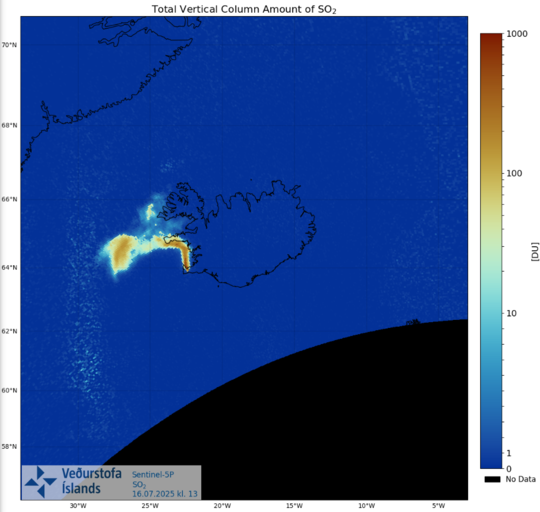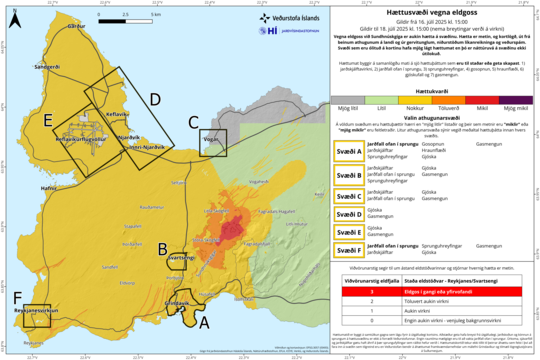The ninth eruption on the Sundhnúkur crater row has ended
Updated 5 August
Ninth eruption on the Sundhnúkur crater row has ended
– new hazard map issued
The volcanic eruption that began on July 16 has now come to an end—for the time being.
Volcanic tremor and explosive activity ceased over the weekend.
No activity has been observed in the craters, according to drone imagery from the police.
Gas pollution and volcanic haze have been minimal in recent days.
Hazards in the area
It is life-threatening to walk on newly formed lava, as the surface crust may collapse without warning and glowing lava may lie just beneath.
The lava front remains hazardous, as sudden lava surges can occur without warning. The lava edge itself may also collapse.
Gas pollution can still exceed danger thresholds in the vicinity of the eruption site.
Yesterday, Monday, activity in the crater came to a complete stop alongside decreasing tremor. Slight activity was visible during the night, but today no activity has been detected, and the eruption is now considered over.
Uplift has resumed, according to satellite and GNSS measurements, by approximately 2–3 centimeters. This confirms that magma is still accumulating beneath Svartsengi, and if uplift continues, it could lead to new magma intrusions and future eruptions.
No significant changes have occurred in the extent of the lava field in recent days, but it remains unstable. This can result in sudden advances at the lava front. In such cases, the surface of the edge may collapse without warning and a glowing lava tongue may surge forward. These surges are life-threatening, and it is essential to keep a safe distance from the edge. This hazard remains even though the eruption has ended.
Gas pollution from the eruption has been low in the area over the past two days, and no volcanic haze has been detected. However, even though crater activity has ceased, there is still a possibility of volcanic haze appearing—sometimes for several days after an eruption ends.
A new hazard map has been issued and will remain in effect for the coming week. The map reflects that the eruption has ended, but hazards due to the newly formed lava and potential gas pollution remain present.
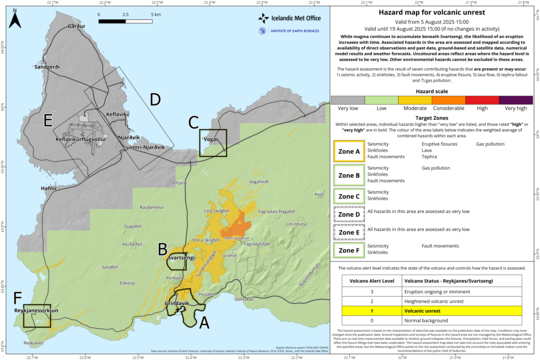
Updated 1 August
Risk of Lava Breakout and Gas Pollution – New Hazard Assessment Map
Dangers in the Area
-
Walking on newly solidified lava is life-threatening, as the surface crust can break without warning and glowing lava may lie just beneath.
-
There is a danger near the lava edge, where thin, fast-moving lava tongues can suddenly surge forward. The edge itself can also collapse unexpectedly.
-
Gas pollution levels can at any time exceed danger thresholds in the vicinity of the eruption site.
Eruption Status
-
Magma accumulation has resumed beneath Svartsengi.
-
The lava field continues to thicken, and lava is flowing partially beneath the surface.
-
A new hazard assessment map is valid until August 5 unless changes in volcanic activity call for a revision.
Volcanic activity continues, with reduced fountaining – Danger Near Lava Edges
The eruption on the Reykjanes Peninsula, which began on July 16, continues with relatively steady intensity. However, the fountaining activity has decreased.
Satellite images from ICEYE, along with measurements from Verkís and Efla, show that the lava field continues to thicken, though no significant changes in its spread have occurred in recent days. This thickening leads to a buildup of pressure that can trigger sudden breakouts at the lava edge. In such cases, the edge can rupture without warning and glowing lava tongues may advance. These breakouts are life-threatening, and it is essential to stay well away from the lava margins.
The latest flow path analyses, based on topography, suggest that lava may move toward Innri Sandhóll, an area where tourists have been gathering.
Measurements Confirm Ongoing Magma Accumulation
Recent deformation measurements confirm continued uplift at Svartsengi. This uplift is observed both on GNSS instruments and InSAR satellite data, which measure ground movement between July 21 and 28.
Weather and Gas Pollution
The weather forecast indicates sharp frontal systems this evening, with possible thunderstorms in the southwest. On Sunday, gas pollution could drift northwest across the country. Light winds today and in the coming days may reduce the dispersion of volcanic haze and increase the likelihood of SO₂ accumulating in populated areas.
Hazard Assessment Map
The hazard assessment map has been updated and is valid until August 5 unless there are significant changes in volcanic activity. The map has been revised in line with the latest gas dispersion forecasts and other hazards. The main change is that the gas pollution risk is now assessed as low in Vogar and Keflavík. In Grindavík, the risk is assessed as low to moderate.
Updated 12:00, 29 July
Gas dispersion, dangers and signs of renewed uplift at Svartsengi
Dangers in the area
It is life-threatening to walk on newly formed lava, as the surface crust can break without warning and glowing lava may lie just beneath.
There is danger near the lava edge, where thin, fast-flowing lava tongues can suddenly surge forward. The lava edge can also collapse unexpectedly.
Gas pollution near the eruption site can exceed danger levels at any time.
Hazard assessment map: Issued 29 July, valid until 1 August unless developments require earlier action.
Status of the eruption
The eruption at the Sundhnúkur crater row continues with steady lava flow from the main crater toward the east and southeast.
There are indications of renewed uplift in the Svartsengi area
A new crater has formed within the main crater, and eruptive activity is now concentrated in this new vent.
Exercise caution at the eruption site
New measurements from EFLA and Verkís show that the lava is still thickening and moving, even though this is not visible on the surface. Tourists are therefore strongly advised against walking on newly formed or recent lava. Even if the surface appears hard and stable, the crust is often only a few centimeters thick and may conceal glowing, molten lava. Lava also retains heat for a long time and can be burning hot even when it looks solid on the surface. Walking on such lava is therefore life-threatening.
Approaching lava edges is very dangerous
The surface of lava edges can break without warning and glowing lava tongues may flow forward. The lava edge itself may also collapse. Therefore, lingering near lava edges is very dangerous.
Current status of the eruption
The eruption at the Sundhnúkur crater row continues with steady lava flow from the main crater toward the east and southeast. A new crater has formed inside the main crater, and activity is now limited to that crater. The small opening that formed yesterday west of the crater has now closed, and there is no activity on the western side of the crater.
Deformation
Deformation observations (GNSS and InSAR) show signs of renewed uplift beneath the Svartsengi area. Currently, these displacements are very small, registering a total uplift of less than 2 cm over the past week. Further measurements within the coming week will confirm whether uplift at Svartsengi continues.
Displacements at the GNSS station SENG in the Svartsengi area over the last 90 days in north, east, and vertical directions (top, middle, bottom). The bottom graph shows vertical uplift in millimeters, with the most recent measurement (July 28) marked by a green dot.
Pollution in the area
Gas pollution can always exceed danger levels near the eruption site. It is important to note that gas emissions also come from the lava field due to degassing.
Gas from the eruption at the Sundhnúkur crater row continues to drift over populated areas in Southwest Iceland. According to the weather forecast, gas pollution may reach the capital area today and tomorrow, and pollution has already been measured in Reykjanesbær and nearby areas. The gas in question is sulfur dioxide (SO₂), which can irritate the respiratory system, especially in people with asthma or other lung conditions.
The public is encouraged to:
Updated Hazard Assessment Map
The Icelandic Meteorological Office has updated its hazard assessment map, which is now valid until Friday, 1 August, unless significant changes in volcanic activity occur.
The current hazard level is assessed as low (green) in the southern part of the Reykjanes Peninsula, on both sides of Grindavík. According to the weather forecast, volcanic gases and ash from the eruption site are expected to be carried northeast during the map's period of validity.
As only one crater remains active, the hazard area around the eruption site has contracted.
It is important that stakeholders consult the IMO's daily gas dispersion forecasts to assess short-term impacts: https://www.vedur.is/eldfjoll/eldgos-a-reykjanesi/gasmengun/
This change in hazard assessment does not significantly affect the assessment within observation areas, where the hazard level remains moderate (yellow). However, the risk from ashfall and volcanic gas emissions is now assessed as very low in Area A (Grindavík) and Area B (Svartsengi).
It is important to note that all hazards assessed as greater than “very low” within observation areas are listed, regardless of whether they arise from the current eruption or from previous eruptions. Hazards assessed as high or very high are shown in bold in the list.
Explanation of terms
Finally, we emphasize that IMO's hazard assessment describes localized hazards from volcanic activity based on measurements and scientific analysis, independent of land use or human presence. Hazard assessment is not the same as risk assessment, which considers population, activities, or assets in the area.
Updated 14:45, 28 July
New lava – hot, unstable, and dangerous
The eruption at the Sundhnúkur crater row continues with steady lava flow to the east and southeast from the main crater. The lava is spreading within about one kilometer from the crater and is thickening, with little movement observed at the outer edges, although measurements show some movement to the north.
Weather at the eruption sites today and tomorrow.
This afternoon, a front coming in from the southwest is moving over the eruption site with southeasterly winds of 10-18 m/s. It should be noted that wind strength increases with altitude, so it is stronger up on the hills around the eruption than down at sea level, e.g. in Grindavík. Associated with the front is rain, low clouds, fog, and poor visibility.
The wind in the area shifts to a much slower southwesterly direction from 9 pm, becoming mainly dry and offering better visibility.
Tomorrow, Tuesday, another front will move in from the west. Southerly 8-13 m/s, rain, low clouds, and poor visibility at the eruption site from noon until midnight tomorrow evening.
On Wednesday, expect southwesterly winds of 8-10 m/s and showers.
Solid on Top, Burning Below: A Hidden Danger
An example of this can be found in the Westman Islands following the 1973 eruption. At that time, the heat from the lava was used for space heating. In 1974, the first house was connected to an experimental heating system, and within a few years, dozens of houses, including the town hospital, became part of what was known as the lava heating system. This solution attracted international attention, as it was the first time in history that heat from fresh lava had been used in this way. The system was in operation for up to fifteen years, until the temperature of the lava fell below usable levels. Read more here.
Hazards at the lava edge
It is also important to warn against lingering near the edges of new lava. The surface can collapse without warning, and lava tongues may suddenly surge forward. Staying near the edge of a lava field is therefore especially dangerous, particularly while the lava is still thickening and settling.
Air pollution in the area
Visitors in the area are encouraged to park only in marked areas, follow marked trails, and proceed with caution. Air pollution may be present both along walking paths and near the eruption site, so it is essential to monitor conditions regularly.
Vulnerable groups, including children, elderly individuals, and those with underlying health conditions, are advised to avoid outdoor exertion and stay away from areas with higher pollution levels.
- More information on gas dispersion is available on the website of the Icelandic Meteorological Office.
- Real-time air quality data can be found on the website of the Environment and Energy Agency.
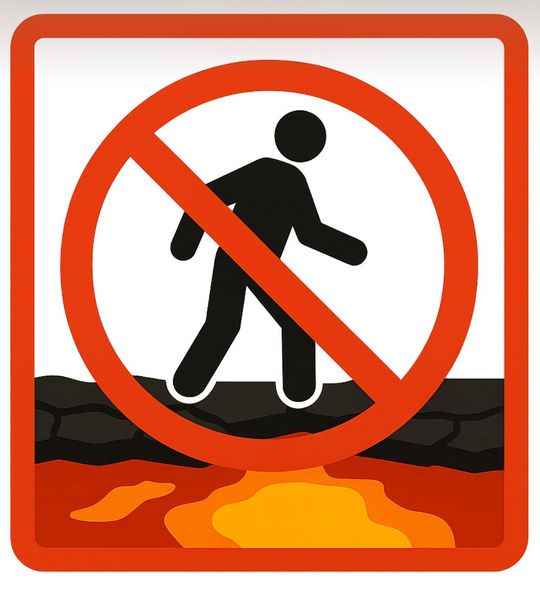
Updated at 11:21 AM, 25 July
Reduced Volcanic Activity but Continued Lava Flow and Thickening
- Volcanic activity has decreased since yesterday morning but has remained stable since then.
- Lava continues to flow east and southeast, spreading within one kilometre of the main crater.
- Little movement is observed at the outer edges of the lava field, and the lava is mostly thickening.
- Seismic tremor has fluctuated in recent days, likely due to alternating buildup and collapse within the crater.
- A thin crust has formed on top of the lava, which may suddenly break and cause rapid lava advancement without warning.
- The highest hazard is considered to be in the southern part of the lava field, near Sandhóll.
- Deformation measurements show no changes beneath Svartsengi – magma inflow and outflow appear to be in balance.
- A new hazard assessment map is in effect until July 29, with the next scheduled update also on that date.
Volcanic activity has decreased since yesterday morning but has remained relatively stable since then, with continued lava flow to the east and southeast from the main crater. The lava is spreading over an area within one kilometer of the crater, and movement at the outermost lava fronts is minimal.
Tremor has fluctuated considerably in recent days, likely due to alternating phases of crater buildup and collapse. Experts caution against overinterpretation, as weather conditions and surface movement within the lava field can influence measurements.
Despite the recent decline in eruptive activity, lava continues to flow eastward from the crater. The lava field covers a large area and is mostly thickening. A thin crust has formed on top of the flowing lava, which may rupture suddenly and cause rapid lava surges without warning. It is therefore crucial to maintain a safe distance from the lava, and any visits near the site should take this hazard into account. This danger is especially present in the southern part of the lava field, near Sandhóll.
Ground deformation measurements indicate no changes in recent days, with no signs of uplift or subsidence beneath Svartsengi. This suggests that magma inflow and outflow within the system are currently in equilibrium and that the eruption is being sustained by magma ascending from deeper layers of the crust.
The map below shows how the outlines of the new lava field changed between July 18 and July 23. These outlines are based on ICEYE satellite images and drone measurements. Most of the lava has flowed southeast toward Fagradalsfjall and has gradually filled depressions along the base of the mountain, both to the north and south.
The weather forecast predicts southeasterly and easterly winds today, meaning that gas pollution will drift northwest and west. As a result, pollution may be detected in the northwestern and western parts of the Reykjanes Peninsula. Later in the evening, winds will shift to a northwesterly direction, potentially bringing pollution to Grindavík. Wind speeds are expected to increase on Reykjanes in the afternoon of July 26, carrying pollution toward the southeast. Very little to no volcanic haze was detected overnight.
A new hazard map is in effect until July 29, based on the weekend's wind forecast. The next full update will be published on July 29 unless changes in volcanic activity occur. However, brief updates will be issued throughout the weekend.
Updated 14:50, 24 July
Continued lava flow and decreasing gas emissions
Volcanic activity has decreased since yesterday morning. One crater is still erupting, and lava continues to flow eastward and south-eastward. Active lava flows spread about one kilometre from the crater and there is little overall expanse of the outer edges of the lava field, aside from limited flow to the south close to Fagradalsfjall.
According to the latest measurements by EFLA, taken on 23 July, the total volume of the new lava in the Sundhnúkur area is now estimated at 26.8 million cubic metres, covering about 3.3 square kilometres. New data show that the volume increased by 5.1 million cubic metres in five days, from 18 to 23 July, corresponding to an average flow rate of about 12 cubic metres per second.
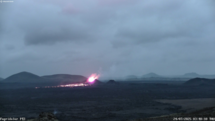
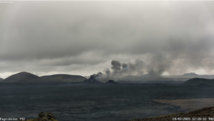
The photo on the left was taken at 3:40 AM, and the one on the right at 12:20 PM today. Both show activity in the main crater of the Sundhnúkur volcanic system. Click the images to view them in full size.
Seismic tremor due to ongoing eruption decreased between 06:00 and 07:00 this morning, in line with decreased volcanic activity in the crater, and has remained relatively low since then. There are no measurable signs of ground deformation in the Svartsengi region, where magma accumulated at depth ahead of the latest eruption.
Gas dispersion and air quality
Measurements of sulphur dioxide (SO₂) from the eruption site this morning show an emission rate between 25 and 44 kilograms per second, a significant decrease from the previous day. Today a south‑easterly wind has carried SO₂ pollution northwest over Njarðvík and Keflavík; it is expected to turn southerly later in the day, and the pollution could then drift over Vogar, the capital region, Akranes and Borgarnes.
Volcanic haze (SO₄) was reported widely this morning, including in Ísafjörður and Strandir. With increasing south‑easterly winds, the haze should diminish in many areas during the day, but calm weather conditions are forecast for Friday, and the haze may return then.
Useful resources:
- Information on air pollution and health risks – Directorate of HealthHealth Hazards from Air
- Pollution Caused by Volcanic Eruptions (PDF) – Directorate of Health
- Air quality measurements Environment and Energy Agency
- Gas dispersion forecast for the eruption – Icelandic Meteorological Office
- Satellite measurements of SO₂ – Copernicus Sentinel-5P
Updated 14:40, 22 July
- SO₂ pollution is expected to drift eastward today, covering large parts of South and East Iceland by the evening. Tomorrow, the pollution is forecasted to spread more widely across the country.
- Only one crater remains active. The northern crater activity ceased at 22:00 last night.
- Ground deformation observations currently show no indication of deformation around Svartsengi
People are encouraged to monitor gas forecasts, air quality, and their own symptoms and reactions.
- The hazard assessment map has been updated and is valid until July 25, unless changing conditions warrant further updates.
Eruption Status
Only one of the two previously active craters is currently erupting. Activity from the northern crater ceased around 22:00 last night. The lava continues to thicken and flow slowly eastward into Fagradal, although the advance is very gradual. Volcanic tremor is gradually decreasing with intermittent fluctuations due to crater rim build-up. Seismic activity remains low in the area.
Ground deformation observations “GPS and InSAR” currently show no indication of either uplift or subsidence in the vicinity of Svartsengi, suggesting that magma inflow and outflow to the system are presently in equilibrium and that the eruption is being sustained by magma inflow from a deeper level within the crust.
The map shows changes in the lava flow outline between July 16 and midday on July 20, based on ICEYE satellite imagery. Most of the lava has flowed northeast toward Fagradalsfjall, slowly filling depressions along the mountain's base both northward and southward. The map also shows the eruption fissures that opened during the event.
Weather Forecast and Gas Dispersion
Due to shifting wind directions across the country, the dispersion of volcanic gases is difficult to predict with precision. However, the IMO´s gas dispersion forecast shows that SO₂ pollution is expected to drift eastward today, potentially affecting large parts of South and East Iceland by evening. Tomorrow, the volcanic haze is forecast to spread over much of the country, covering South, East, and West Iceland.
The image shows the IMO´s gas dispersion forecast for Wednesday, July 23, at 6 AM.
The new forecast maps below show SO₂ dispersion from the eruption on the Reykjanes Peninsula. The left map predicts conditions at 06:01 on July 22. The right map shows the forecast for 00:00 on July 23, 2025.
The area affected by the forecast has expanded and now includes potential dispersion toward the UK.
Click on the images to view them in full size.
The forecast is based on the FALL3D modeling system using weather forecasts and an assumed emission rate (100 kg/s), produced in collaboration between the Icelandic Meteorological Office, CSIC, and Leonardo Mingari.
A low-pressure trough is currently over the country, resulting in variable wind directions, although westerly winds dominate in the southwest. Fog and drizzle are expected on the coast. Today's precipitation may help reduce the pollution caused by the eruption.
People are encouraged to monitor the IMO´s gas dispersion forecast, the Environment and Energy Agency of Iceland's air quality measurements at loftgaedi.is , and especially their own reactions.
Hazard Map Update
The hazard map has been updated and is valid until July 25 unless conditions change. The hazard level is currently assessed as low (green) across parts of the southern Reykjanes Peninsula. Weather forecasts suggest that winds during the validity period will carry volcanic gases and ash away from this region.
This update does not affect hazard levels within monitoring zones, where the hazard is still considered moderate (yellow).
Tourists and tour operators are advised to monitor air quality when traveling near the eruption site, particularly in areas where gas pollution and volcanic haze can change rapidly with the weather.
Useful resources:
- Information on air pollution and health risks – Directorate of HealthHealth Hazards from Air
- Pollution Caused by Volcanic Eruptions (PDF) – Directorate of Health
- Air quality measurements Environment and Energy Agency
- Gas dispersion forecast for the eruption – Icelandic Meteorological Office
- Satellite measurements of SO₂ – Copernicus Sentinel-5P
Updated 10:30, 21 July
Important to monitor the gas dispersion forecast and your own reaction to the pollution
The eruption at the Sundhnúkur crater row has caused significant air pollution in recent days, both due to gas pollution (SO₂) and volcanic haze (SO₄). Volcanic haze has been detected widely, it forms when sulfur dioxide (SO₂) reacts with moisture and oxygen in the atmosphere, creating fine sulfate particles that can travel long distances and linger over populated areas for extended periods.The air quality monitoring network operated by the Environment and Energy Agency shows concentrations of SO₂ and particulate matter (PM1 and PM2.5).
Yesterday, most readings were in the green range, indicating low SO₂ levels despite the presence of haze. This is because the haze no longer registers as SO₂ but as fine particulate matter after transformation. Today, however, actual SO₂ pollution has been measured.The gas dispersion forecast from the Icelandic Meteorological Office only covers SO₂ and does not predict volcanic haze distribution. We therefore encourage the public to check both the forecast and the air quality measurements available on loftgaedi.is and, above all, pay attention to symptoms that might result from prolonged exposure to polluted air.
Vulnerable individuals, such as children, pregnant women, people with asthma, COPD, cardiovascular disease, and those aged 60 and older, are particularly advised to avoid spending extended periods outdoors if they experience any discomfort.Guidance on how to protect oneself and loved ones from volcanic air pollution can be found on the website of the Directorate of Health. The Directorate also offers educational material explaining the health impacts of volcanic pollution and how best to respond.
Useful resources:
Information on air pollution and health risks – Directorate of HealthHealth Hazards from Air
Pollution Caused by Volcanic Eruptions (PDF) – Directorate of Health
Environment and Energy AgencyGas dispersion forecast for the eruption – Icelandic
Meteorological OfficeSatellite measurements of SO₂ – Copernicus Sentinel-5P
Important to monitor the gas dispersion forecast and your own reaction to the pollution
The eruption at the Sundhnúkur crater row has caused significant air pollution in recent days, both due to gas pollution (SO₂) and volcanic haze (SO₄). Volcanic haze has been detected widely, but the air quality monitoring network operated by the Environment and Energy Agency does not fully capture its distribution and concentration. We therefore encourage the public to monitor the Icelandic Meteorological Office's gas dispersion forecast carefully and, above all, pay attention to symptoms that might result from prolonged exposure to polluted air.
The eruption remained steady overnight, with activity in two craters in the central part of the fissure. Lava continues to flow eastward into Fagradal, but poor visibility makes it difficult to assess developments.
The Icelandic Meteorological Office forecast predicts gas pollution in South and West Iceland today, 20 July. Light and variable winds until late Monday could cause persistent volcanic haze over the southwest part of the country.
Vulnerable groups, such as children, older people, and people with heart or lung conditions, are particularly advised to avoid spending extended periods outdoors if they experience any discomfort. Guidance on how to protect oneself and loved ones from volcanic air pollution can be found on the website of the Directorate of Health.
Key advice for reducing SO₂ pollution indoors:
Keep windows and external doors closed as much as possible.
Turn off ventilation systems where applicable.
Ventilate rooms once outdoor air quality has improved.
Forecast from the Icelandic Meteorological Office for sulfur dioxide (SO₂) distribution over the next 24 hours, from 10:00 on 20 July to 10:00 on 21 July. The pink areas indicate where the highest concentrations could occur near ground level. Persistent volcanic haze is expected until late Monday.
Earthquake widely felt
At 2:55 AM on Sunday, a magnitude 3.5 earthquake was recorded in Móhálsadalur west of Kleifarvatn. When magma intrudes into the crust, it creates stress on both sides of the magma intrusion that occurred on 16 July. This stress is released in triggered earthquakes, which are a sign of stress release; they do not indicate magma movement in the areas where they are sourced or felt. The earthquake was widely felt, including in the capital area and Hveragerði.
Additional information
Air quality in Iceland. The Icelandic Environment and Energy Agency. Data is updated every 10 minutes.
Gas pollution forecast. Icelandic Meteorological Office. A map shows areas in the country where sulphur pollution is expected for the next 48 hours (Icelandic)
Registration form for gas pollution in inhabited areas. Icelandic Meteorological Office (Icelandic)
Updated 11:30, 19 July
Eruption at Sundhnúkur crater row – Ongoing volcanic haze across Iceland
The volcanic eruption on the Sundhnúkur crater row remains active, with gas and volcanic haze spreading widely across the country in recent days. The eruption has remained stable overnight and since yesterday morning. Volcanic activity is focused on 2–3 craters at the central part of the fissure that formed on 16 July, and volcanic tremor remains low and steady.
Air pollution is not confined to areas near the eruption as it can travel long distances and linger over inhabited areas for extended periods.
Volcanic haze has formed under calm wind, humidity, and sunshine, affecting regions such as West Iceland, North Iceland, and the capital region. This pollution appears mainly in two ways:
-
Gas pollution from sulfur dioxide (SO₂) near the eruption site.
-
Volcanic haze, formed when SO₂ reacts with moisture and oxygen in the atmosphere, turning into fine sulfate particles (SO₄) that can spread far and persist.
The latest meteorological forecasts indicate light winds from the west or variable directions, allowing pollution and haze to drift widely over South and Southwest Iceland, and even into the highlands in the coming hours.
The public is advised to monitor air quality at air quality (measurements and guidance) and vedur.is (forecasts and maps). Those sensitive to air pollution – such as children, elderly people, and individuals with lung conditions – should take precautions when volcanic haze levels are high.
Further information
-
Air quality in Iceland – Environment and Energy Agency: data updated every 10 minutes.
-
Gas pollution forecast – Icelandic Meteorological Office: maps showing areas expected to be affected by sulphur dioxide pollution over the next 48 hours.
-
Health advisory on volcanic air pollution – Directorate of Health (PDF).
-
Sentinel-5P web viewer – maps showing the spread of sulphur dioxide pollution over Europe and the Atlantic on a daily basis, based on satellite measurements.
Updated at 11:30, 18 July
Status of the eruption and volcanic haze across Iceland
The eruption at the Sundhnúkur crater row continues, though its activity has decreased over the past 24 hours. The main activity is now concentrated at the central part of the fissure, and little to no seismic activity has been measured along the intrusion. Tremor around the eruption sites has also diminished.
No ash has been produced by this eruption, and therefore it has not affected air traffic to or from Iceland.
Volcanic pollution and haze across Iceland – current conditions and advisories
Air pollution from volcanic eruptions mainly occurs in two distinct ways:
-
Gas pollution from sulphur dioxide (SO₂) rising with the magma, primarily affecting areas near the eruption site.
-
Volcanic haze forms when SO₂ gas reacts with moisture and oxygen in the atmosphere under sunlight, converting into fine sulphate particles (SO₄). The impact of this haze can be substantial or severe far from the eruption site and may persist for an extended period.
Gas pollution from the eruption has now spread widely across the country and can also be clearly seen over the ocean north and west of Iceland. Volcanic haze has formed in considerable amounts under the current weather conditions, light winds, humidity, and sunshine, and has been observed across large parts of Iceland. The haze has been particularly noticeable in North and West Iceland, where both measurements and visual observations confirm its presence.
People sensitive to respiratory issues, children, and the elderly should avoid prolonged outdoor activity and reduce physical exertion while pollution persists. Healthy individuals may also experience discomfort. It is recommended to close windows and reduce indoor ventilation where applicable, and to air out homes when pollution subsides.
Volcanic haze is widespread, especially in the north and west of the country. The weather forecast predicts light winds in the coming days, with variable wind directions and showers across Iceland. Such conditions favour the persistence of volcanic haze in certain areas.
Further information
-
Air quality in Iceland – Environment and Energy Agency: data updated every 10 minutes.
-
Gas pollution forecast – Icelandic Meteorological Office: maps showing areas expected to be affected by sulphur dioxide pollution over the next 48 hours.
-
Health advisory on volcanic air pollution – Directorate of Health (PDF).
-
Pollution recording form – Icelandic Meteorological Office: for reporting gas pollution in inhabited areas.
-
Sentinel-5P web viewer – maps showing the spread of sulphur dioxide pollution over Europe and the Atlantic on a daily basis, based on satellite measurements.
Developments are being closely monitored, and updated data are published regularly on the Icelandic Meteorological Office website.
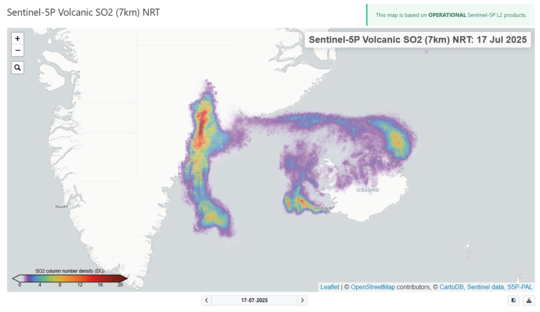
Distribution of sulphur dioxide (SO₂) from the eruption at the Sundhnúkur crater row on 17 July 2025, according to data from the Copernicus Sentinel-5P Mapping Portal.
Updated at 15:50, 17 July
Update from yesterday's situation: new hazard map in effect
-
The eruption continues, but activity has decreased and is now confined to around 10 craters
-
Lava flow is mainly heading towards Fagradalsfjall within foreseeable areas
-
Low seismic activity and declining tremor
-
SO₂ pollution has temporarily reached hazard thresholds in some localized areas
-
Gas dispersal today towards Reykjanesbær, potential pollution in Grindavík tomorrow
-
Updated hazard map valid until 22 July, no changes to color codes
Eruption status
The eruption at the Sundhnúkur crater row continues, though activity has decreased and is mostly confined to around ten craters. Lava is still flowing, mainly eastward towards Fagradalsfjall, and remains within expected areas.
Seismic activity is low and tremor is declining. Deformation measurements show no significant changes since yesterday. Fog and poor visibility are currently limiting observations of the eruption site.
Gas dispersal
Gas dispersal has been widespread, but SO₂ concentrations have only temporarily reached hazardous levels in some localized areas, including Akureyri. Today, 17 July, southeast winds are expected, meaning gas may be carried towards Reykjanesbær and surrounding areas. Tomorrow, light northerly winds are forecast, with potential pollution in Grindavík.
Hazard map and validity period
An updated hazard map has been published to reflect the extent of the lava field. No changes are expected to the color codes while the eruption continues. The Icelandic Meteorological Office (IMO) will continue to closely monitor developments and update information as needed. Gas dispersion forecasts can be found at: https://www.vedur.is/eldfjoll/eldgos-a-reykjanesi/gasmengun/
The IMO's hazard map has been updated and is valid until 22 July unless significant changes in activity occur.
Main updates and reasons
The main update is that the extent of the lava field has been revised based on aerial mapping, and variable wind directions during the map's validity period (the next five days) have been taken into account. Changing wind directions mean that gas pollution, ash, and pollution from vegetation fires can spread in all directions from the eruption site. Therefore, the risk from airborne pollution is considered moderate (shown in yellow on the map). It is important for stakeholders to consult IMO's daily gas dispersion forecasts to assess day-to-day conditions.
Monitoring areas and hazards
No changes have been made to the defined monitoring areas. It is important to clarify that all hazards assessed as higher than very low within monitoring areas are listed, regardless of whether the hazard originates from the current eruption or previous eruptions. The reason lava is specified for Area A (Grindavík and surroundings) is that hazards remain from lava flows from the January 2024 and April 2025 eruptions. Hazards assessed as significant or very significant are highlighted in bold in the list.
Explanation of terms
Finally, we emphasize that IMO's hazard assessment describes localized hazards from volcanic activity based on measurements and scientific analysis, independent of what is present in the area. Hazard assessment is not the same as risk assessment, which considers population, activities, or assets in the area.
Pollution associated with the eruption
Pollution associated with the eruption has been notable in recent days. The pollution situation is as follows:
-
Pollution from vegetation fires is currently considered the greatest hazard in inhabited areas, but such pollution is not detected by SO₂ sensors and therefore does not appear in conventional pollution forecasts
-
Sulfur dioxide (SO₂) has been measured widely across Iceland, most significantly in West Iceland and also in North and East Iceland
-
Pollution dispersal depends on prevailing wind directions, so localized pollution levels can change rapidly from day to day
Gas concentrations have generally been decreasing since yesterday morning, but temporary local increases may occur in line with changes in wind and eruptive activity. We therefore stress the importance of consulting IMO's daily gas dispersion forecasts to assess day-to-day impacts.
This photo was sent to us yesterday by Jón Guðbjörn Guðjónsson, weather observer and postman in Árneshreppur. The image shows volcanic haze over the northern part of Strandasýsla as seen from the weather station at Litlu-Ávík on the afternoon of 16 July.
Photo: Jón Guðbjörn Guðjónsson, weather observer in Árneshreppur.
Updated at 17:30
Updated hazard assessment map due to the eruption near Sundhnúkar
The Icelandic Meteorological Office has issued an updated hazard assessment map, valid until 15:00 on 18 July unless activity changes. The alert level for the volcanic system remains at the highest level, 3.
The hazard assessment is based on recent observations and shows the following:
-
The eruptive fissure has lengthened and now extends farther north than previous fissures since December 2023.
-
Lava flow continues but has decreased in intensity.
-
Most of the lava is accumulating east of the fissure and is likely to fill depressions in the area.
-
Seismic activity has decreased significantly, now measuring only a few small earthquakes per hour.
-
Gas emissions and wildfires continue to contribute to pollution.
Volcanic tremor and activity
The eruption at Sundhnúksgígaröð continues, but measurements show a decline in its intensity since this morning. The image below shows the development of tremor measurements at seismic station Fad, north of Fagradalsfjall. The lines represent vibration strength across different frequency bands.
Strong tremor was recorded early this morning as the eruption began but has steadily decreased since.
Lava extent
The map below is based on ICEYE satellite observations taken shortly before noon today and shows the extent of the lava from this eruption. At that time, the lava field covered approximately 3.2 km².
The map also shows the estimated location of the eruptive fissure at Sundhnúksgígaröð at around 12:00. Lava has flowed north and northeast from the source, spreading widely across Kálffellsheiði and toward Svartsengi.
The light purple color indicates the new lava field, red lines mark fissures, and the brown grid delineates the observation area and populated areas.
Sulfur dioxide in the atmosphere
Wildfires are currently considered the greatest hazard to inhabited areas, but pollution from these fires is not detected by SO₂ monitors and is not reflected in the current air quality forecast.
The image below shows sulfur dioxide (SO₂) concentrations over Iceland at 13:33 on 16 July 2025, according to Sentinel-5P satellite measurements. Colors indicate pollution strength: light blue for low concentrations, reddish-brown for high concentrations.
High concentrations are measured over the Reykjanes Peninsula, extending west and southwest over the ocean with the wind.
Hazard assessment for the eruption
Below is the hazard assessment map from the Icelandic Meteorological Office, showing the current assessment of hazards due to the eruption near Sundhnúksgígaröð and how hazard zones are defined based on the current situation. The map describes both existing hazards and those that could develop if activity continues.
All defined observation areas on the map are colored yellow (some hazard), but the map also highlights red zones where the greatest hazards from lava, tephra, and gas pollution could occur.
The hazard assessment map will next be updated on 18 July unless changes in activity or weather require earlier action.
The hazard assessment describes the hazards currently present in the area as well as those that could develop if activity continues in the Svartsengi system.
Updated at 12:00
The latest observations show that the eruption is no longer confined to a single fissure. The larger fissure at the Sundhnúkur crater row is estimated to be about 2.4 km long. In addition, a smaller fissure has opened west of Fagradalsfjall and was estimated at about 500 meters in length during an aerial survey by the Icelandic Meteorological Office and the Icelandic Coast Guard.
Updated at 08:45
Seismic activity has decreased during the early morning, but lava flow continues, moving both east and west, with a greater flow to the east. Poor visibility limits the overview, particularly to the west.
So-called "witch's hair" has been reported drifting in the wind. These are fine glass fibers formed when lava droplets cool rapidly and stretch. They are very light and can travel long distances. Witch's hair can cause skin and eye irritation, and people are advised to take precautions when outdoors near the eruption site.
High levels of gas pollution are being measured in Reykjanesbær but are decreasing. Residents are advised to stay indoors, keep windows closed, and turn off ventilation systems. It is best to breathe through the nose.
This report will be updated as new data becomes available. An updated hazard map is being prepared and will be published later today.
Updated 5:20
Southeasterly winds today, gas pollution can be expected over Reykjanesbær, Vogar, Sandgerði and Garð.
A link to IMO's gas dispersion.
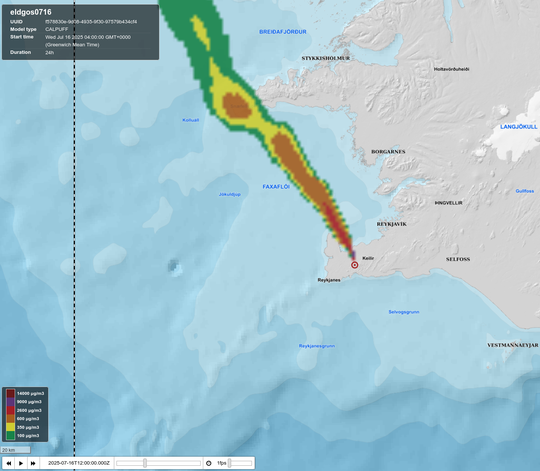
Updated at 5:05
The eruptive fissure is approximately 700 to 1000 m long. The fissure has been propagating to the north since the eruption started.
Lava is mostly flowing to the SE and is not approaching any infrastructure.
Below is a screenshot from a webcamera located just north of Fagradalsfjall and is looking towards SW.
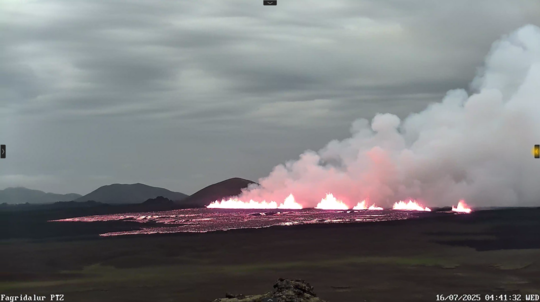
Updated at 3:56
An eruption has started. The location is southeast of Litla-Skógfell.
Updated at 3:10
The earthquake activity is more intense north of the area where the swarm started.
The hazard assessment has been updated.
Updated at 2:25
The earthquakes in the seismic swarm are mostly occurring at 4 to 6 km depth. That indicates that magma is not moving towards the surface at this point.
Updated at 2:11
According to seismicity and real time GNSS data the dike forming below the Sundhnúksgígar crater row is moving southwards rather than north.
Updated at 01:55
According to real time GNSS data the deformation is still minor indicating that the seismicity is still small compared to previous events.
Updated at 01:20
Intense seismic swarm has started on the Sundhnúkur Crater Row and monitoring data
Intense seismic swarm has started on the Sundhnúksgígar Crater Row and monitoring data is indicating that an dike intrusion has started. The likelihood of an eruption remains high while the intrusion is ongoing.
The seismicity is located between Stóra-Skógfell and Sýlingarfell, a similar location as previous dike intrusion started on the Sundhnúksgígar Crater Row.
The news will be updated
